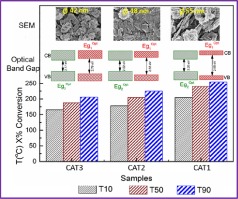Journal of the Taiwan Institute of Chemical Engineers ( IF 5.7 ) Pub Date : 2018-09-14 , DOI: 10.1016/j.jtice.2018.08.014 Patrick Mountapmbeme Kouotou , Achraf El Kasmi , Ling-Nan Wu , Muhammad Waqas , Zhen-Yu Tian

|
This study reports the control of catalytic properties of Fe3O4 thin films through adjusting the particles size and optical properties. Structure analysis of the obtained materials by X-ray diffraction indicated the formation of pure magnetite structure of Fe3O4. X-ray photoelectron spectroscopy showed that the surfaces of the samples were mainly composed of Fe2+, Fe3+, O2−, CO32− and OH−. Scanning electronic microscopy displayed a smooth films surface with an agglomerated crystallite grains. Both XRD and SEM exhibits particles size increases (∼40 to ∼60 nm) with the substrate temperature (Ts), while micro-strain in the sample decreased. The correlation of the Ts with optical energy band gaps (EgOpt) determined from UV visible (UV–vis) measurements indicated the increase of indirect (2.17 ≤ Eg2Opt≤ 2.25 eV) and direct (2.78 ≤ Eg1Opt≤ 2.95 eV) band gap of Fe3O4. Fe3O4 samples have been successfully tested towards the total oxidation of CO. While the change in EgOpt of Fe3O4 has been explained on the basis of the variation in the grain size and likely adsorbed oxygen (OAds) with Ts, the catalytic performance was suggested to be strongly dependent on the films microstructure, catalysts surface composition and more importantly with the EgOpt and OAds variation. Moreover, theoretical calculations based on DFT method of CO oxidation over Fe3O4 film surface catalyst demonstrated that OAds was the most involved oxygen species during the catalytic process, revealing that the LH mechanism is the most appropriate route for the CO catalytic oxidation over MvK and ER mechanisms. This approach of highlighting the interplay among the particle size, optical and catalytic properties with DFT calculations can pave the way to better understand the catalytic behavior of other transition metal oxides.
中文翻译:

PSE-CVD衍生的Fe 3 O 4薄膜的粒径带隙能催化性质关系
这项研究报告了通过调节颗粒尺寸和光学性能来控制Fe 3 O 4薄膜的催化性能。通过X射线衍射对获得的材料进行结构分析,表明形成了Fe 3 O 4的纯磁铁矿结构。X射线光电子能谱显示,样品的表面主要由Fe 2+,铁3+,O- 2-,CO 3 2-和OH - 。扫描电子显微镜显示光滑的膜表面具有团聚的晶粒。XRD和SEM均显示出随着基板温度(〜40 nm〜〜60 nm)的粒径增加(〜40至〜60 nm)T s),而样品中的微应变降低。T s与通过紫外可见(UV-vis)测量确定的光能带隙(Eg Opt)的相关性表明间接(2.17≤E g2 Opt)的增加≤2.25 eV)和直接(2.78≤E g1 Opt≤2.95 eV)Fe 3 O 4的带隙。已成功测试了Fe 3 O 4样品对CO的总氧化的作用。同时,Fe 3 O 4的E g Opt的变化已根据晶粒尺寸和可能的吸附氧(O Ads)的变化进行了解释。T s,表明催化性能强烈依赖于膜的微观结构,催化剂的表面组成,更重要的是随着E g Opt和O Ads的变化。此外,基于DFT方法对Fe上的CO进行氧化的理论计算3 O 4薄膜表面催化剂表明,O Ads是催化过程中涉及最多的氧种类,这表明LH机理是通过MvK和ER机理进行CO催化氧化的最合适途径。这种通过DFT计算来突出粒径,光学和催化性能之间相互作用的方法,可以为更好地理解其他过渡金属氧化物的催化性能铺平道路。



























 京公网安备 11010802027423号
京公网安备 11010802027423号